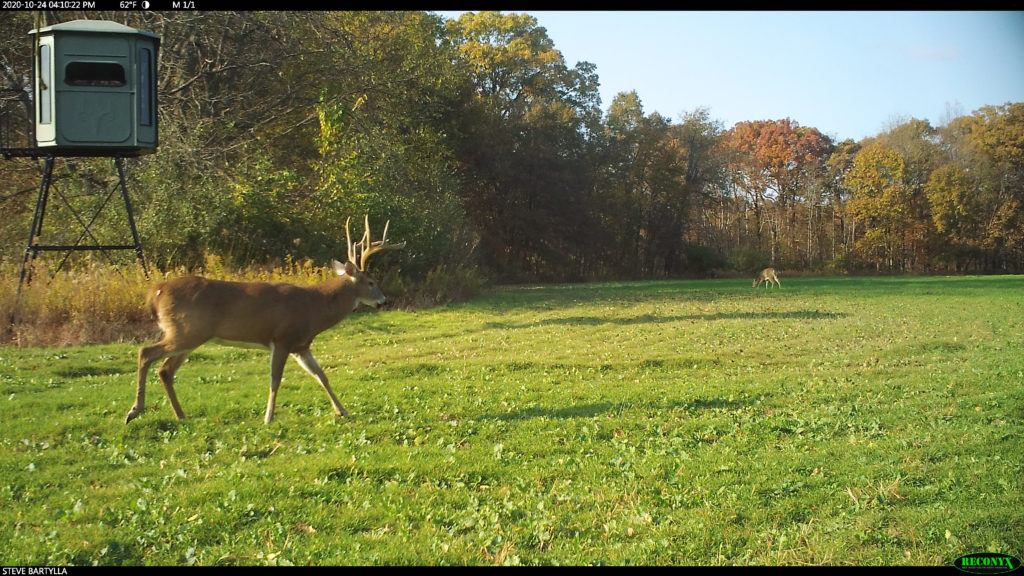The term home range is used often in the deer world, but what does it actually mean? Do deer ever leave their home ranges, and why would they do such things? Well, these answers and more are about to become clear.
This is Chapter 2 of Steve Bartylla’s free online book, Understanding Mature Bucks.
Last chapter, we talked about some overall differences between mature bucks and does. We need to continue that for at least another post, while introducing a couple topics to the conversation.
Right off the bat, bucks born on a specific chunk of dirt rarely spend their entire lives there. They spend their first late spring and summer with the birth doe. As the rut approaches (generally between mid-October to early November in the Midwest and points north), the birth doe, her daughters and/or the birth does’ sisters harass that young buck away from the family group to minimize gene sharing.
In most habitats, the .5-year-old buck reunites with the family group after the birth doe has finished being in estrus (in heat). However, in areas of highly segmented deer cover (generally found in the Western states, where small pockets of deer cover are separated by miles of open range), that .5-year-old buck actually disperses at that time to set up a new home range of his own.
In more typical deer cover, not so spread out in pockets, that dispersal, referred to as yearling buck dispersal, occurs when he is driven out by the family group before his second rut, at 1.5 years of age.
Now, we must quickly define home ranges. They are nothing more than the area the buck spends some level of time in most every year. Add up all that ground and you have their home range. No deer spends equal amounts of time in all areas of their home range. In fact, the area he spends most of his daylight hours in is referred to as his core area. He may have multiple core areas and they may change multiple times a year, heck, even within the same week, but, after yearling buck dispersal, his home range rarely changes significantly.

Now, as with most everything deer behavior related, there are exceptions to this. Every now and then, mature bucks will abandon their existing home range for a completely different one for no obvious or apparent reason, but those are relatively few and far between. (I’m sure there are good reasons. I just can’t always tell why/what they are.)
What is a constant is that a deer’s home range has to be as big as needed to provide all a deer needs for survival over the year. If it doesn’t, the home range either must be expanded to the point it does or the deer dies from a lack of whatever needed resource.
In the largest part due to that alone, home ranges generally are bigger the worse the habitat is at meeting their needs and tend to be considerably smaller in truly top-end deer habitat, which is particularly true when deer numbers and competition/social stresses are higher.
Now, during the rut, a mature buck’s home range tends to expand a bit. Personally, I don’t believe it’s on purpose. Frankly, I think the majority of those rut expansions are due to getting on a pretty-smelling doe that happens to overlap his home range. When she leaves his range, I don’t believe the imaginary home range line stops him from following her for a second. The overwhelming majority of time, he returns when he’s done, but those minor excursions do result in his home range technically expanding a bit during the rut.
As a side note, occasionally, bucks take off for points unknown during the rut, only to return toward the end of the rut or never again. Most often, I believe that’s due to the domino effect of estrus and near-estrous does during the rut.
Think about it. During peak rut there will be a lot of pretty-smelling girls running around. One tempts him off his home range, only for him to stumble across another pretty-smelling doe that didn’t overlap with his home range, taking him even farther away. He doesn’t snag her, for whatever reason. No worries, there’s another pretty-smelling girl! The catch is that she’s even farther away now. Play that out in your mind and it becomes really easy to see how a buck could end up 10-20 miles away from his home range, while chasing a series of does.
As a final side note, because the family groups are wired differently and don’t have the pressure of being driven to spread their genes across the lands, family group home ranges can be and most often are considerably smaller than those of mature buck home ranges, generally around half the size or even less.
Read Chapter 1: Whitetail Tendencies












